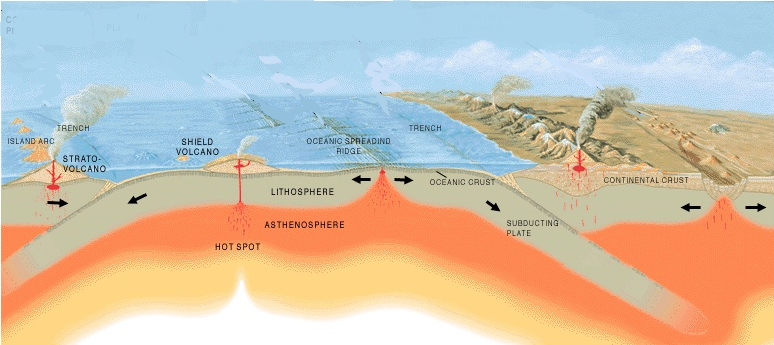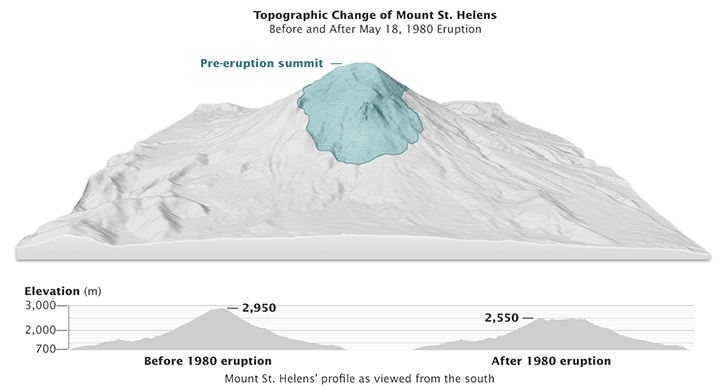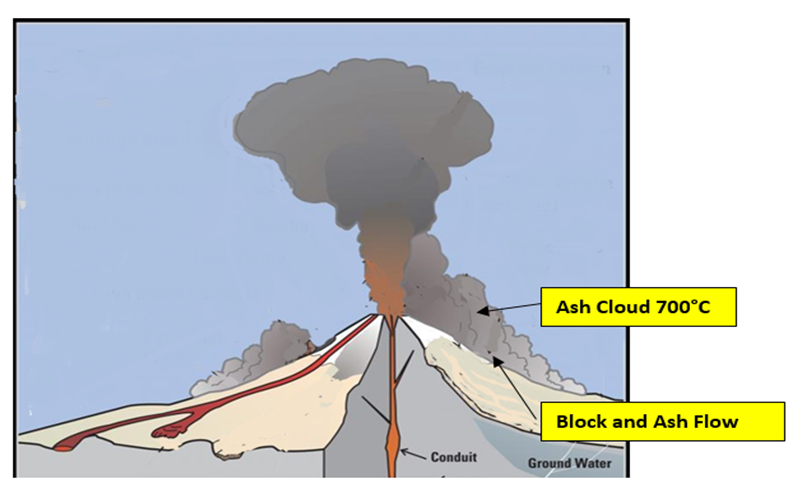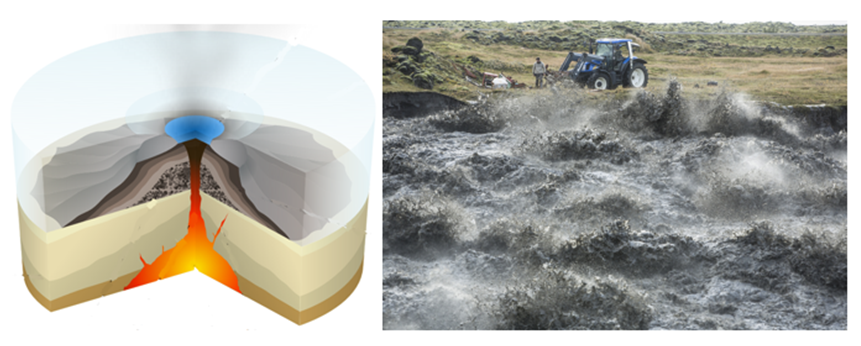Types of Volcano and Associated Hazards
Types of Volcano and Associated Hazards
This page includes detailed resources on the three main types of volcanoes and their associated eruptions and hazards. The lesson begins with a short map activity based on the Mount St Helens eruption. Students then go on to complete annotated diagrams of the three main types before using the animated presentation and gallery to complete the worksheet on types of eruptions and causes. There is also a detailed PDF resource for note-taking on processes at plate boundaries as well as several interactive resources. Students then complete a card sorting activity on types of volcanic hazards before classifying them into primary and secondary hazards. There is a plenary quiz and noting sheet to complete as well as a model exam question.
Enquiry Question
How do volcanoes vary from place to place?
Lesson Time: 3 Hours
Lesson Objectives:
- To describe and explain the processes, features and hazards at different plate boundaries
- To describe the characteristics of volcanoes including shield, composite and cinder
- To explain the different types of volcanic eruption; and associated secondary hazards, including pyroclastic flows, lahars, landslides
Teacher Notes:
Starter - Using the map evidence and the diagram students should explore the nature of the eruption and the types of hazards experienced
Plate Boundary Processes and Features - Students can then use the interactive map provided to complete the noting sheets on the types of plate boundaries, processes and associated hazards. Teacher talk needs to support this as follows to their work. This is a time-consuming activity so plenty in addition to the follow-up.
Volcano types - Students can then complete the worksheet on types of volcanoes either working independently on the site or it can be teacher-led.
Types of Eruption - You can then use the excellent animation to explain silica-rich magma and explosivity differences with eruptions- students complete the noting sheet that goes with this.
Lesson 3 - Starter Activity - Types of Volcanic hazards - Hand out the card sort and students can match the diagram of the hazard with the correct name and explanation.
Types of Volcanic Hazard - The starter can be followed up with the noting worksheet based on the card sort
Plenary Activity - Use the drag and drop activity to match the hazards to the correct place on the diagram
Student Assessment - Contrasting volcanoes - Students should then answer the assessment (in class) to explain the characteristics and associated hazards of two contrasting volcanoes.
Student Textbook Links
Student Activity - Plate Boundaries - Processes
Using the interactive resource below complete the worksheets on plate boundaries and volcanic activity
Student Activity - Volcano Types - Processes
Using the resources below complete your worksheet on the three main types of volcano
Cinder Cones
Cinder cones are one of the most common types of volcanoes and are less dangerous compared to other types. They usually reach heights between 30 and 400 meters. They are formed normally through a single vent and opening. The volcano forms a steep cone shape with a single crater. Its slopes are made of erupted cinder material and have an angle of between 30 and 40 degrees.
The eruption of cinder cones can be very sudden and can last for several years before becoming extinct or dormant. When the volcano erupts, lava is ejected but cools rapidly in the air coming cinder. These fragmented cinders fall a short distance from the opening, creating the cone.

Paricutin Cinder Cone, Mexico
Shield Volcanoes
Shield volcanoes can be very big, although their size is often hidden by the ocean. Shield volcanoes can be huge because of their ample supply of magma. For example, Mauna Loa in Hawaii rises more than 9000 meters above its base on the bottom of the ocean. Shield volcanoes may be tall but tend to be very broad, with less steep slopes than other volcanoes. They have slopes of around 10 degrees, reducing to 5 degrees near the summit.
The eruption of lava out of shield volcanoes consists of fast-flowing lava, usually ah ah lava, which is low in viscosity and fast-moving. This explains the huge breadth of shield volcanoes.
Composite Volcanoes
Composite volcanoes or strato-volcanoes are large volcanoes rising to 3000 meters in height and can range anywhere from 1-10 km in diameter. The structure of composite volcanoes is tall and symmetrical with steep sides, around 6 degrees, rising to 30 degrees close to the crater.
Their eruptions are dangerous and explosive, with many layers of lava and pyroclastic materials, the current of rock and gas that can reach over 900 °C and travel at speeds faster than 700 kmph. In addition, they erupt hot gases, ash, lava, and pumice as well as stiff, slow-moving lava. Moreover, deadly mudflows—also commonly known as ‘lahars’—can also accompany the eruption.
Student Activity - Types of Eruption - Processes
Study the animation below and add notes to your worksheet to explain:
- why magma rises through the crust
- the different types of magma
Student Activity - Volcanic Hazards - Processes
Study the card sort and:
- match the diagram with the correct hazard title and description
- sort the hazards into primary and secondary hazards
Noting Worksheet
Pyroclastic Flow
Pyroclastic flow is a fast-moving current of hot gas and volcanic matter (collectively known as tephra) that moves away from a volcano reaching speeds of up to 300 km/h and temperatures of between 700°C and 1,000 °C. At the lower layer, the flow moves in a sheet form as a layer of thick ash and gas. In the upper layer an ash cloud forms. Pyroclastic flows normally touch the ground and move fast downhill, or spread laterally under gravity. Their speed depends upon the density of the current, the volcanic output rate, and the gradient of the slope.
Mount St Helens Eruption
The Eruption Column
This primary hazard results directly from the eruption and varies in size depending on the type of eruption. Plinian eruptions can reach 20-40km in height. The lower section is known as the gas thrust region and forms due to the pressure release of trapped gas within the magma chamber. Above this convective currents lift the column higher before it mushrooms out into the umbrella region
Ash Fall
Ash fall from ash clouds covers the largest area and is made up of tephra, which is fine pieces (2mm) of pulverized rock, minerals and volcanic glass. Ash fall on the surface can reach meters in height and clog rivers and lakes. When combined with heavy rainfall from storms, fast-moving mudflows called lahars result. Acid rain is also s secondary hazard associated with ash fall. In addition, the air is choked with as, which can lead to both humans and animals to asphyxiate. Heavy ash fall can also cause weak roofs in homes and barns to collapse.
Lava Flow
Lava flows are the least hazardous of all processes in volcanic eruptions. How far it travels depends on the temperature, silica content, extrusion rate, and slope of the land. Slower lava flow is associated with composite volcanoes due to its high silica content and viscosity. Faster flowing lava such as a lava and pahoehoe lava are low viscosity so flow much further from the volcano spreading over larger surface areas
Pahoahoa Lava
A a Lava
Lahars
Lahars are a type of mudflow composed of a slurry of pyroclastic material, rocky debris, and water. The material flows down from a volcano, typically along a river valley. Lahars vary in size and speed. Small lahars are less than a few meters wide and several centimetres deep may flow a few meters per second. Large lahars hundreds of meters wide and tens of meters deep can travel at fast speeds. With the potential to flow at speeds up to 100 kilometres per hour, and flow distances of more than 300 kilometres, a lahar can cause catastrophic destruction in its path.
Landslides
The surface of volcanoes is unstable and made mostly of loose rock. This means they are easily susceptible to landslides. Volcanic gases create acidic groundwater, which contributes to the rocks' breakdown, increasing the weakness and instability in the volcano flank, and further increasing the likelihood of landslides.
Glacial Outburst Floods
A glacial outburst flood can be triggered by geothermal heating and occasionally by a volcanic subglacial eruption. Sometimes referred to as jökulhlaups based on their Icelandic name they emerge from hydrostatically-sealed lakes with floating levels far above the threshold, their peak discharge can be much larger than that of a marginal or extra-marginal lake burst. They cause rapid and devastating floods in and around the immediate location of the volcano and glacier.
Student Activity - Name that Hazard - Processes

- A. Landslide
- B. Pyroclastic Flow
- C. Lahar
- D. Lava Tube
- E. Eruption Column
- F. Ash Fall
Student Assessment - Exam question - Processes
Study the diagram below.
Explain the characteristics of two contrasting types of volcanoes and their associated hazards located on the diagram. (3+3)
Clear and accurate reference to types of volcanoes and their location in terms of plate boundary
Excellent knowledge and understanding of how volcanoes and their associated hazards contrast, evidence in terms of place examples

Tectonic Processes and Associated Volcanic Activity






.jpg)












